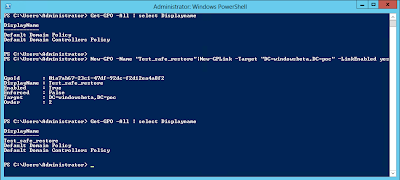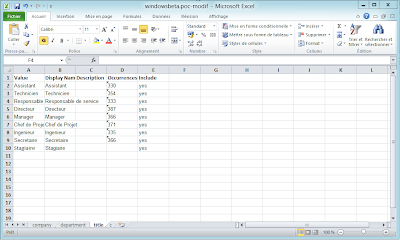Microsoft Virtual Academy just published a great series of videos on Windows Server 2012.
Microsoft Virtual Academy Technet Video
Blog dedicated to Microsoft Infrastructure and more particularly to Active Directory, IdM and Security
mercredi 23 mai 2012
lundi 21 mai 2012
[Microsoft Solution Accelerators] Microsoft Assessment and Planning Toolkit 7.0 Beta available
Microsoft Assessment and Planning Toolkit 7.0 Beta is now available.
The Microsoft Assessment and Planning (MAP) Toolkit’s new capabilities help you assess the readiness of your environment for deploying Windows 8 and Windows Server 2012 Beta. This update adds eight new scenarios that help you build the fabric of the future while supporting your business needs of today. Included are hardware and infrastructure readiness assessments to plan your deployment of Windows 8 and Windows Server 2012 Beta, size your desktop virtualization environment, ready your information platform for the cloud with SQL Server 2012, and virtualize your existing Linux servers onto Hyper-V. The VMware migration assessment helps you identify opportunities to lower your virtualization costs with Hyper-V and the licensing assessments now cover Lync 2010 Standard and reporting for active users.
Key features and benefits of MAP 7.0 Beta help you:
- Determine your readiness for Windows Server 2012 Beta and Windows 8
- Virtualize your Linux servers on Hyper-V
- Migrate your VMware-based virtual machines to Hyper-V
- Size your server environment for desktop virtualization
- Simplify migration to SQL Server 2012
- Evaluate your licensing needs for Lync 2010
- Determine active users and devices
Download Microsoft Assessment and Planning Toolkit 7.0 Beta
samedi 12 mai 2012
[Windows 8 Server] Virtualized Domain Controller Part 2 (Safe Snapshot Restore)
Here's the second part of Virtualized Domain Controller new capabilities.
Today we'll see the Safe Snapshot Restore part.
You can found more informations in the Virtualized Domain Controller TLG and Virtualized Domain Controller UTG.
My lab is composed of 1 Hypervisor and 2 VM, all running Windows 8 Server Beta (prerequisite for Virtualized Domain Controller).
First here's the UTG explanation about restoring snapshot of Domain Controller and problems that it brings.
Virtualization creates unique challenges to distributed multi-master workloads that depend upon logical clock-based replication schemes. AD DS replication uses an increasing transaction value assigned to transactions on each domain controller, known as an Update Sequence Number. If a domain controller "rolls back" time during application of a snapshot, a USN may be reused an entirely different transaction; replication cannot converge since other domain controllers believe they already received the update.
So, first we take a snapshot of the second DC.
Now I restore the snapshot.
And we can see what happened on the DC which was restored through logs.
After the restore, everything is ok. Dcdiag, repadmin don't show any errors.
Of course it can't be used as a backup of Active Directory but it will surely useful when something is wrong with the DC or to avoid problems due to a snapshot restore mistake.
Today we'll see the Safe Snapshot Restore part.
You can found more informations in the Virtualized Domain Controller TLG and Virtualized Domain Controller UTG.
My lab is composed of 1 Hypervisor and 2 VM, all running Windows 8 Server Beta (prerequisite for Virtualized Domain Controller).
First here's the UTG explanation about restoring snapshot of Domain Controller and problems that it brings.
Virtualization technology such as Hyper-V includes snapshot abilities, where you create an image of a domain controller at a point in time. Restoring the snapshot discards all changes made since that checkpoint and in previous operating systems, forces the domain controller to quarantine itself with a process called USN rollback protection. Once USN rollback protection is in place, a domain controller no longer replicates again and must be either forcibly demoted or manually restored non-authoritatively. In cases where the domain controller has originated changes since the snapshot was taken, it also leads to lingering objects.
Windows Server "8" Beta now detects rollbacks and non-authoritatively synchronizes the delta of changes between a domain controller and its partners for AD DS and SYSVOL. You can now use snapshots without risk of permanently crippling domain controllers and requiring manually forced demotion, metadata cleanup, and re-promotion. While this does not prevent other issues with snapshots - such as inconsistent databases for other technologies and applications - it does make domain controller virtualization safer.
So, first we take a snapshot of the second DC.
After that, I create a new GPO and force the replication between the 2 DC.
Now I restore the snapshot.
And we can see what happened on the DC which was restored through logs.
After the restore, everything is ok. Dcdiag, repadmin don't show any errors.
Of course it can't be used as a backup of Active Directory but it will surely useful when something is wrong with the DC or to avoid problems due to a snapshot restore mistake.
mardi 8 mai 2012
[Data Classification Toolkit] Active Directory Claims Wizard
I've already presented Data Calssification Toolkit : [Windows 8 Server] Data Classification Toolkit for Windows Server 8 Beta.
We'll see today more particularly the Active Directory Claims Wizard.
You can use the Active Directory Claims Wizard to provision new claims or update existing claims with suggested values based of AD DS data
Two options are available in the Active Directory Claims Wizard :
- Scan Active Directory forest or domain claim values
- Upload claim values to Active Directory forest
First we use the first option to scan the AD DS data for possible source attributes to use for building new claim values.
I've already provionned my AD DS forest with about 2800 users.
I've also created 4 Claim Types (Company, Department, Title and Country) in ADAC. I'll base on them later for the classification.
We launch the Active Directory Claims Wizard :
We choose the first option :
We target just the AD DS domain :
We launch the scan :
We save the export :
The first part is now finished, we can open the export to see which different values have the 4 claim types.
We can now check all the values and modify or add new values if needed.
I choose to add 3 new values (2 company and 1 title).
Moreover I set the Include column to yes for each row to report to include all of the suggested values that must be defined for the claims.
Now we can upload claims values with this modified file.
We choose our modified file and upload values :
We can see that 4 claims have been modified and 45 suggested values added.
Now I go back to ADAC and see what have been changed in the claims.
As you can see all the values of the file have been added to the suggested values in the claims types.
Active Directory Claims Wizard is a very great tool, easy to use and very helpful for enterprise administrator who plan to deploy Dynamic Access Control.
Inscription à :
Commentaires (Atom)


























